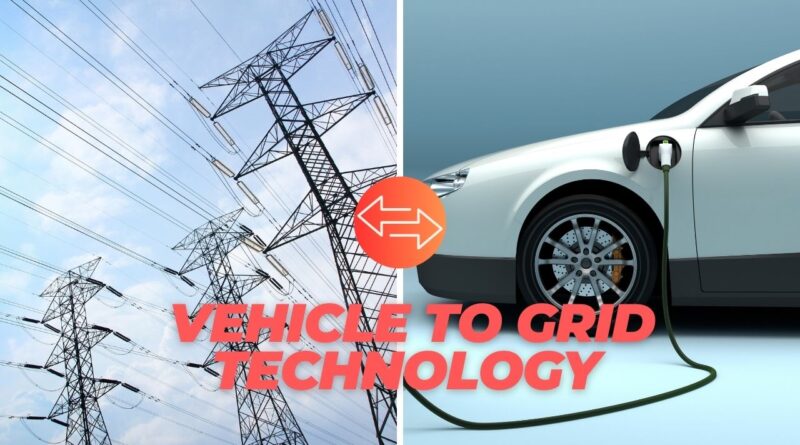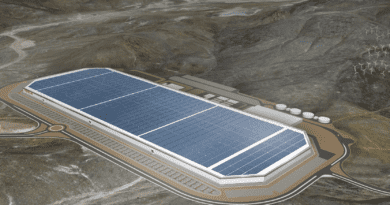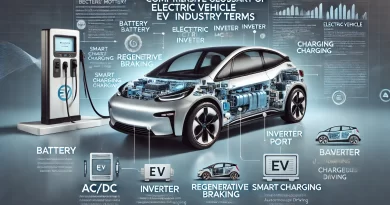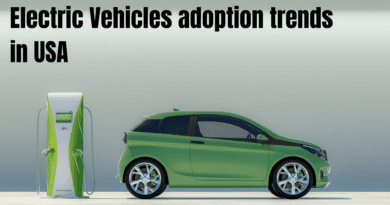What Is Vehicle-to-Grid Technology? How Vehicle-to-Grid technology works?
Introduction
Vehicle-to-Grid (V2G) technology represents a significant innovation in the realm of electric mobility and energy management. As the adoption of electric vehicles (EVs) accelerates globally, the integration of V2G technology offers a transformative approach to utilizing the battery capacity of EVs not just for transportation, but as dynamic assets in the electric grid. This article delves into the intricacies of V2G technology, exploring its workings, benefits, and the challenges that lie ahead.
What is Vehicle-to-Grid Technology?
Vehicle-to-Grid (V2G) technology allows bidirectional energy flow between electric vehicles (EVs) and the power grid. In essence, EVs equipped with V2G capabilities can not only draw electricity from the grid to charge their batteries but also discharge stored energy back into the grid. This bidirectional flow of energy creates a flexible and interactive energy ecosystem, where EVs can act as mobile energy storage units.
How Does V2G Work?
The functioning of V2G technology hinges on several key components and processes:
- Bi-directional Chargers: Unlike conventional EV chargers, bi-directional chargers enable energy to flow in both directions. They can charge the EV battery from the grid and discharge energy back to the grid. These chargers are essential for V2G operations as they facilitate the dynamic exchange of energy.
- Communication Systems: Advanced communication systems are crucial for V2G technology. These systems enable seamless interaction between the EV, the charger, and the grid operator. They ensure that energy exchanges are optimized based on real-time data regarding grid demand, energy prices, and the EV’s state of charge. Smart meters and IoT devices play a vital role in this communication infrastructure.
- Smart Grid Integration: V2G technology is a cornerstone of smart grid infrastructure. The smart grid employs sophisticated algorithms and communication networks to manage energy distribution efficiently. It can instruct V2G-enabled vehicles to discharge energy during peak demand periods or absorb excess energy during low demand periods. The integration of AI and machine learning can further enhance the efficiency of these processes.
- Energy Management Systems (EMS): These systems oversee the overall energy flow within the V2G framework. EMS algorithms determine the optimal times for charging and discharging EV batteries based on factors such as grid stability, energy prices, and the user’s preferences. They can also manage the aggregation of multiple EVs to provide a substantial energy reserve for grid services.
Benefits of V2G Technology
V2G technology offers a multitude of benefits that span across economic, environmental, and grid stability aspects:
- Grid Stability and Reliability: V2G can enhance grid stability by providing ancillary services such as frequency regulation, voltage control, and spinning reserves. During peak demand periods, EVs can discharge energy to alleviate pressure on the grid, thereby preventing blackouts and maintaining a stable power supply. This capability transforms EVs into valuable assets for grid operators.
- Renewable Energy Integration: V2G supports the integration of renewable energy sources such as solar and wind into the grid. By acting as distributed energy storage units, V2G-enabled EVs can store excess renewable energy during periods of high generation and supply it back to the grid when renewable output is low. This helps in mitigating the intermittency issues associated with renewable energy sources.
- Economic Benefits: EV owners can earn additional income by participating in V2G programs. By selling excess energy back to the grid during peak demand periods, EV owners can offset their energy costs and even make a profit. Additionally, utilities can defer costly infrastructure upgrades by utilizing the distributed energy storage capacity of V2G-enabled vehicles. This creates a win-win situation for both EV owners and utilities.
- Environmental Impact: V2G technology can reduce greenhouse gas emissions by optimizing the use of renewable energy and minimizing reliance on fossil fuel-based power plants. The ability to store and discharge renewable energy enhances the overall sustainability of the energy ecosystem. Furthermore, it can contribute to the reduction of carbon footprints associated with transportation and energy production.
Current Challenges of V2G Technology
Despite its promising potential, V2G technology faces several challenges that need to be addressed for widespread adoption:
- Infrastructure Development: The deployment of V2G technology requires significant investments in bi-directional chargers, communication systems, and smart grid infrastructure. Developing a robust and standardized V2G infrastructure is essential for seamless integration and widespread adoption. Public and private sector collaboration is crucial to accelerate infrastructure development.
- Regulatory and Policy Frameworks: Clear and supportive regulatory frameworks are crucial for V2G implementation. Policies need to address issues related to grid interconnection, energy pricing, data privacy, and cybersecurity. Harmonizing regulations across different regions can facilitate the growth of V2G technology. Governments and regulatory bodies must work together to create conducive environments for V2G adoption.
- Battery Degradation: Frequent charging and discharging cycles can accelerate battery degradation in EVs. This poses a challenge to the long-term viability of V2G technology. Advances in battery technology and management systems are needed to mitigate the impact of V2G operations on battery health. Research and development in solid-state batteries and advanced battery management systems can provide solutions to this challenge.
- Consumer Awareness and Acceptance: Educating consumers about the benefits and opportunities of V2G technology is essential for its success. Building trust and acceptance among EV owners regarding the safety, reliability, and economic advantages of V2G participation is a critical step. Public awareness campaigns and incentives can play a significant role in increasing consumer acceptance.
- Market Dynamics: The market dynamics of V2G technology are still evolving. The business models for V2G services need to be clearly defined and economically viable for all stakeholders involved. This includes defining roles and responsibilities for EV owners, utilities, grid operators, and service providers. Developing transparent and fair market mechanisms can drive the commercialization of V2G technology.
What Are the Different Types of Vehicle-to-Grid Systems?
Several use cases exist for electric car batteries forming part of power grids. These include:
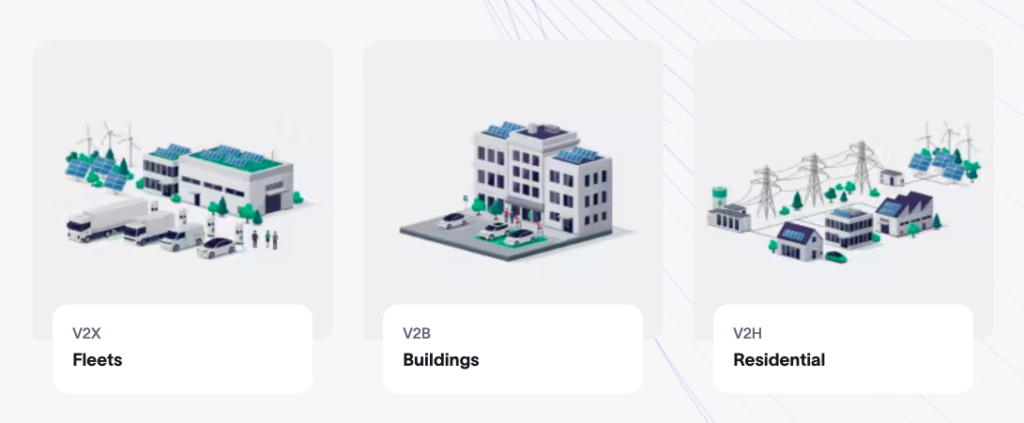
- Vehicle-to-Grid (V2G): This is the traditional concept where EV batteries push electricity back into the power grid. It involves a direct connection between the vehicle and the grid, allowing energy to flow from the EV battery to support grid operations.
- Vehicle-to-Home (V2H): In this scenario, an EV battery powers a home. Depending on power use, an EV can provide between two to five hours of power or longer. This can be particularly useful during power outages or in areas with unreliable electricity supply.
- Vehicle-to-Building (V2B): Similar to V2H, but on a larger scale, V2B systems allow EV batteries to power larger buildings. This can help in reducing energy costs and enhancing the energy resilience of commercial and industrial buildings.
- Vehicle-to-Vehicle (V2V): This involves using one EV battery to charge another electric vehicle. It can be particularly useful in scenarios where one vehicle has depleted its battery and another has surplus energy to share.
- Vehicle-to-Everything (V2X): This is a more comprehensive approach, utilizing bidirectional charging for various use cases, such as charging a home, an appliance, or even feeding energy back into the grid. Bidirectional charging stations offer two-way charging capabilities, making V2X a versatile solution.
- Vehicle-to-Load (V2L): Some EV batteries can power appliances like power tools, lights, or camping equipment. This capability makes EVs useful in off-grid scenarios or during outdoor activities where access to electricity is limited.
All these acronyms fall under a larger umbrella strategy called Vehicle-Grid Integration (VGI). This idea brings together all these charging and discharging concepts. VGI’s overarching aim is to meet the needs of EV drivers while simultaneously benefiting the power grid and boosting the energy system’s efficiency and reliability.
Technical Aspects of V2G Technology
To better understand V2G technology, it is important to delve into its technical aspects:
- Bidirectional Power Flow: The core technical feature of V2G technology is bidirectional power flow. This requires advanced inverters that can convert AC to DC for charging the EV battery and DC to AC for discharging energy back to the grid. The efficiency and reliability of these inverters are critical for the performance of V2G systems.
- Grid Interconnection Standards: V2G technology must comply with grid interconnection standards to ensure safe and reliable operations. Standards such as IEEE 2030.5 and IEC 61850 provide guidelines for V2G communication and grid integration. Adherence to these standards ensures interoperability and compatibility of V2G systems with existing grid infrastructure.
- Energy Storage Optimization: Efficient energy storage and management are vital for V2G technology. This involves optimizing the state of charge (SoC) of EV batteries to balance between transportation needs and grid services. Advanced algorithms and predictive models can enhance the accuracy and efficiency of energy storage optimization in V2G systems.
- Cybersecurity Measures: Ensuring the cybersecurity of V2G systems is paramount to protect against potential cyber threats. Robust encryption, authentication, and intrusion detection systems are necessary to safeguard the communication networks and data exchanges in V2G technology. Collaborative efforts between cybersecurity experts and V2G developers can enhance the security posture of V2G systems.
Case Studies and Real-world Applications
Several pilot projects and real-world applications of V2G technology provide valuable insights into its potential and challenges:
- Nissan and Enel’s V2G Pilot in Denmark: In Denmark, Nissan and Enel have partnered on a V2G pilot project involving Nissan LEAF vehicles. The project demonstrated the feasibility of V2G technology in providing grid services and generating revenue for EV owners. The success of this pilot has paved the way for larger-scale V2G deployments in Europe.
- Tokyo Electric Power Company’s V2G Initiative: Tokyo Electric Power Company (TEPCO) has initiated V2G trials in Japan, leveraging EVs to enhance grid stability and integrate renewable energy. The trials have shown promising results in managing peak demand and supporting the grid during emergencies. TEPCO’s initiative highlights the potential of V2G technology in densely populated urban areas.
- California’s V2G Programs: In the United States, California is at the forefront of V2G technology adoption. Several V2G programs are underway, involving school buses, public transportation fleets, and private EVs. These programs aim to reduce emissions, support renewable energy, and provide cost savings for participants. California’s regulatory support and favorable market conditions have accelerated the growth of V2G technology.
Future Prospects of V2G Technology
The future of V2G technology is promising, with several trends and advancements shaping its trajectory:
- Integration with Renewable Energy: The integration of V2G technology with renewable energy sources will continue to grow. As solar and wind power generation increases, V2G-enabled EVs can play a crucial role in storing and balancing renewable energy. This synergy can significantly enhance the sustainability and resilience of the energy grid.
- Advancements in Battery Technology: Ongoing advancements in battery technology, such as solid-state batteries and improved battery management systems, will enhance the performance and longevity of V2G operations. These innovations will address the challenge of battery degradation and increase the overall efficiency of V2G systems.
- Expansion of V2G Infrastructure: The expansion of V2G infrastructure, including bi-directional chargers and smart grid integration, will accelerate the adoption of V2G technology. Public and private sector investments in infrastructure development will be critical to support the widespread deployment of V2G systems.
- Global Regulatory Support: Global regulatory support for V2G technology will play a pivotal role in its growth. Harmonized regulations and policies that promote V2G adoption, address interoperability issues, and incentivize participation will drive the commercialization of V2G technology worldwide.
- Consumer-centric Business Models: Developing consumer-centric business models that offer clear economic benefits and convenience to EV owners will be key to the success of V2G technology. Transparent pricing mechanisms, flexible participation options, and user-friendly interfaces will enhance consumer acceptance and participation in V2G programs.
Companies Developing V2G Technologies
Several companies are at the forefront of developing and implementing Vehicle-to-Grid (V2G) technologies, driving innovation and adoption in this sector. Here are some key players:
- Nuvve Corporation: Nuvve is a global leader in V2G technology, offering a platform that integrates EVs into the grid to manage power dynamically. They collaborate with automakers, charging infrastructure providers, and utilities to provide turnkey energy management solutions. Their technology supports various applications, including V2G, V2B (Vehicle-to-Building), and V2H (Vehicle-to-Home).
- Toyota: Toyota is actively involved in V2G research and has partnered with San Diego Gas & Electric (SDG&E) to explore bidirectional power flow technology. This collaboration focuses on how Toyota’s electric vehicles can support the grid and customers through improved energy reliability and cost reductions.
- The Mobility House: This Mobility House company works on integrating EVs into the energy market, allowing EV batteries to provide services to the grid. They have been involved in various V2G pilot projects across Europe, showcasing the financial and practical benefits for grid operators and EV owners.
- Honda and Mitsubishi (ALTNA): These companies have formed a joint venture to optimize EV usage costs and extend the lifetime value of EV batteries. ALTNA focuses on V2G smart charging and aims to integrate EV batteries into grid storage solutions, enhancing grid stability and supporting renewable energy integration.
- Fermata Energy: Fermata Energy specializes in developing bidirectional chargers and V2G platforms. Their technology is used in various pilot projects to demonstrate the viability of V2G systems in supporting grid operations and providing cost savings to EV owners.
- Enel X: Enel X is actively involved in V2G technology and has implemented several projects that integrate EVs with the grid. Their solutions aim to balance renewable energy fluctuations and provide ancillary services to grid operators, contributing to a more stable and efficient energy system.
These companies are leading the way in developing and deploying V2G technologies, contributing to a more sustainable and resilient energy future.
Conclusion
Vehicle-to-Grid technology holds immense potential to revolutionize the way we think about energy and transportation. By transforming electric vehicles into dynamic energy assets, V2G technology can enhance grid stability, support renewable energy integration, provide economic benefits, and contribute to environmental sustainability. Overcoming the challenges related to infrastructure, regulations, battery health, and consumer awareness will be key to unlocking the full potential of V2G technology. As the world moves towards a more sustainable and resilient energy future, V2G technology stands out as a pivotal innovation in the transition to cleaner and smarter energy systems.

